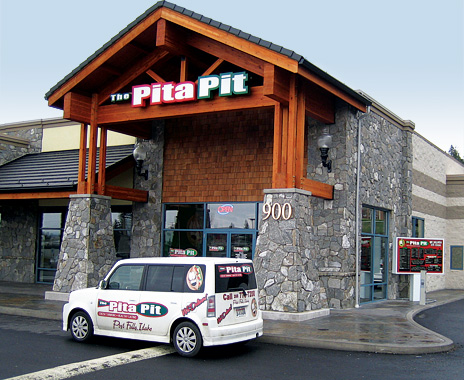It’s no secret that technology has changed nearly every facet of the quick-service industry, from back-of-house software and cooking equipment to the automation of the guest experience. The changes are even being seen in the rapid rise of location-based technologies like geofencing, beacons, and radio frequency identification (RFID), which restaurants across the industry are using to enhance their marketing efforts and improve the ordering process.
With the help of GPS and RFID, geofencing allows brands to set up virtual “fences” around their units. Those ping the smartphones of customers outside the restaurant in a specific geographic area and drive them into the store. Once inside or at the drive thru, operators can use beacons to offer customized offers and messages intended to increase revenue and build brand loyalty.
Sandwich chain Pita Pit has experimented with geofencing in the past, using digital ad buys to target customers in a one-mile radius around each of its 240 stores. Each ad was customized to reflect the restaurants in that market, pushing menu items and touting features like online ordering, as well as providing directions to the stores. The brand also plans to roll out beacon technology at corporate units this fall.
“With the geofencing and the beaconing, we can tell which customers are coming frequently and deliver a more aggressive offer to get people in our doors,” says digital marketing manager Jordy Patano.
Pita Pit also uses the technologies to reward loyal customers with free items based on their past preferences and orders. “It’s more of that surprise-and-delight angle with the beacons,” Patano says, adding that location-based software allows the brand to incentivize guests based on their buying behavior, greet them by name when they walk in the store, and capture data that allows Pita Pit’s marketing dollars to go farther than they have in the past.
“Data is king,” says Vince Crimaldi, vice president of the consumer products, retail, and distribution unit at management consulting firm Capgemini. “Restaurants want to know their customers better, because by knowing their customers, they can personalize the convenience options and give them their food where they want it, when they want it, and how they want to order it.”
By knowing who is in their restaurant at any given time (and what they’re ordering when they’re there), brands can target their marketing messages on a one-by-one basis and sell based on each guest’s likes and dislikes. For example, if a customer using a geofencing app has ordered a particular menu item in the past, a restaurant can offer that guest a discount on the item to drive them to the store to purchase again.
“You have a connection to a consumer through their mobile device, and that connection has the ability to understand their preferences,” says Garrett Dodge, CEO of entertainment platform Rockbot. That can include how often they visit, which stores they visit, what they order, and how they want their order fulfilled. The combination of that information and the beacon allows operators to suggest what customers should order, upsell them, and let them repurchase what they ordered before, he adds. Those tools can increase marginal revenue, as well as decrease service time.
While many brands are using these technologies to provide customized marketing messages, others are using them to enhance the ordering process. Last year, sandwich chain The Melt rolled out a customized geofencing app that guests can use to place, track, and control orders.
“For customers that have already placed an order with us, if they are within a geofence from our store, we’ll send them a notification to say, ‘We see that you’re near our store, we know that you already have an order, would you like us to go ahead and get started on that?’” says director of development Jay Llacuna. By doing so, The Melt can ensure a guests’ orders are hot and ready to go the moment they step through the door.
In addition to using it for beacons and geofencing, fast-casual brands are employing RFID to provide casual-dining table service, says Capgemini’s Crimaldi. By broadcasting signals from the tables, servers can figure out which guest purchased what order and then deliver that order to them at their table. “This is an immediate enhancer to the dining experience,” he says. “You get the convenience and speed of a quick-service restaurant with the experience of a full-service restaurant.”
Crimaldi also predicts that this technology will be incorporated into the drive thru moving forward, with brands using RFID to determine which car ordered what, as well as beacons to upsell based on guests’ previous orders.
Though the advantages of these location-based technologies are clear—and still being discovered—there are a number of challenges that come with adopting and employing geofencing and beacons. While the cost of entry has decreased dramatically since their introduction to the market several years ago, the cost of rolling out, maintaining, and upgrading the technology can be significant, Dodge says.
Brands also have to be careful about invading guests’ privacy when using beacons and geofencing apps, which is one reason Llacuna says The Melt has held off on marketing through the technology just yet.
“Some people find that type of thing invasive or scary because brands know where they’re at,” he says, adding that any moves into beacon marketing in the future will come with opt-in-or-out capabilities to ensure guests don’t feel like the brand is infringing upon their privacy.
Despite the challenges, Llacuna expects these technologies to become a necessity for any limited-service brand that wants to remain relevant in the future.
“It’s going to become a must-have feature for all businesses, especially restaurants,” he says. “When the technologies start to mature and become a little less proprietary and more standardized, it’s going to be one of those things where you need to have that feature.”











